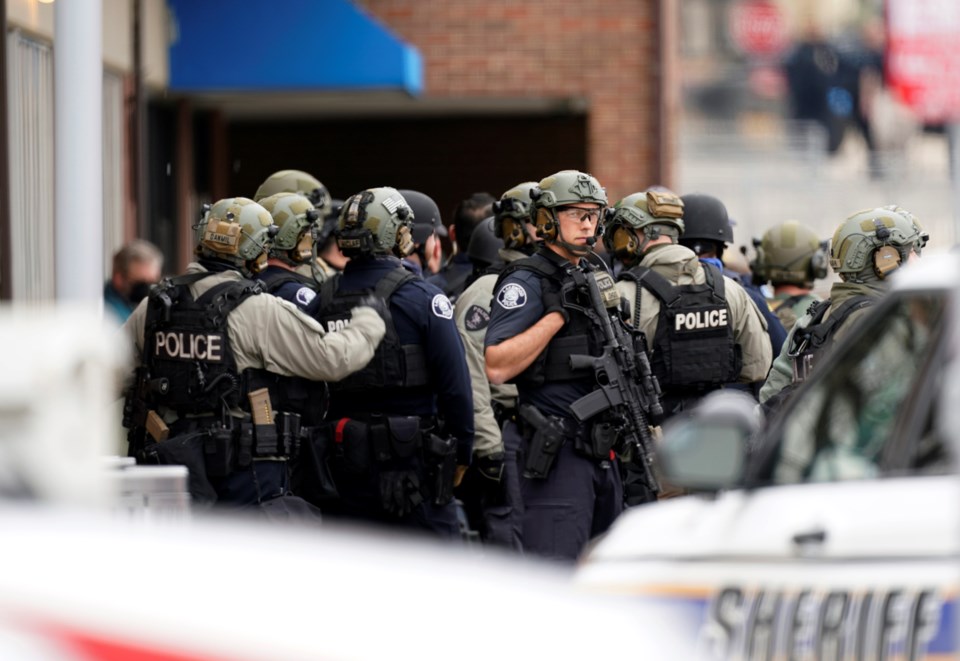Editor’s note: This story was originally published by The Denver Post and was shared via AP StoryShare.
Amid the eulogies and ceremonies, the presiding priest at Boulder police Officer Eric Talley's funeral for a moment directed his comments directly at the hundreds of officers who gathered in the Lafayette church to mourn the officer killed while responding to a report of an active shooter.
"This service would have been for any one of you if you had been first on the scene," Rev. Daniel Nolan said at the funeral. "That is a risk every day you put on your badges."
When Talley and two other officers charged into the Boulder King Soopers, they were following modern police strategy on responding to reports of an active shooter. They pulled up to the store, grabbed equipment from their cars and, about a minute after arriving, ran into the building to immediately confront the suspect. They didn't pause to wait for back up or a more heavily-armed SWAT team. They weren't even wearing helmets, video shows.
"Talley, (unintelligible), and myself are going in," one of the three officers radioed into dispatch after arriving at the store, her voice shaking.
Modern policing strategy teaches officers to engage a suspect as quickly as possible and distract him from other people, tactics experts said. But the strategy is inherently risky for officers, data shows. Not only are active shooter incidents becoming more common, but the number of officers wounded or killed in connection to the events is increasing.
“If you look over time, it does appear that officers are being shot more often in active shooter events than in the past," said Pete Blair, executive director of the Advanced Law Enforcement Rapid Response Training at Texas State University.
Today's tactics mean that patrol officers, not specially-trained SWAT teams, are often the first to engage a suspect, Blair said. Waiting for a SWAT team to mobilize and arrive on scene takes too long, as Front Range police learned in 1999 when responding to Columbine High School. For several years, training recommended officers wait to form a team of at least four or five, but more recently guidance has shifted to even smaller teams or solo officers confronting a suspect alone.
“Colorado has unfortunately played a big role in forming the tactics for policing," said Paul Taylor, assistant professor at University of Colorado Denver and a former University of Colorado Boulder police officer. "Columbine really changed the way law enforcement looks at these incidents."
Police did not enter Columbine High School for more than 40 minutes after they learned a shooting had begun. Instead, the first officers on scene formed a perimeter around the school south of Denver and waited for SWAT teams to arrive. The delay drew criticism from survivors and victims' families, but law enforcement leaders said the officers were following their training at the time.
Training provided by ALERRT at Texas State University teaches there are three phases to initial contact with an active shooter: distract, isolate and neutralize.
“Oftentimes just the police presence gets the suspect to stop looking for victims and to think about the police,” Blair said.
That appears to have worked inside the King Soopers. Law enforcement have said that the suspect did not shoot anyone else after Talley and the other two officers confronted him.
A timeline of the shooting compiled by The Denver Post shows that officers were inside the building four minutes after being dispatched to the scene. Seventeen minutes after the first dispatch, police used an armored vehicle to break the store's windows and SWAT teams entered the building about 50 minutes after the first dispatch, quickly taking the suspect into custody.
Data compiled by Blair and other researchers at ALERRT show that officers were shot while responding to active shooters in one of every six active shooting events recorded between 2000 and 2018. Police officers were shot in 42 of 277 active shooter incidents in that time period.
Some events included multiple injuries or deaths. A total of 76 officers were shot in those active shooter situations, and 21 died. Those numbers include officers responding to a call as well as officers ambushed by a suspect.
The reason for the increased lethality is twofold, Blair said. Going in faster with smaller teams means that police are more likely to confront the shooter while the killing is ongoing, which is inherently more dangerous. Second, officers are encountering more suspects who are willing to engage police or who are actively seeking to harm officers, like the shooter in Dallas who in 2016 shot and killed five officers and injured 11 others, including two people who were not police.
In response, many departments have allotted patrol rifles, heavier vests, ballistic helmets and even protective shields to patrol units -- equipment that previously would have been reserved for special teams, Taylor said. Patrol officers often also go through active shooter training, not just SWAT teams, he said.
“To get a patrol officer up to a point where they can do that, it takes a significant amount of training, and you're sacrificing other trainings," he said.
The reality that any officer could be asked to confront an active shooter has become a norm in policing, Taylor said, similar to how the possibility of a mass shooting has become normalized in U.S. society as a whole.
Public sentiment clearly shows that people expect an officer to confront a gunman, Taylor said, citing the outrage that a Florida school resource officer faced for not confronting the gunman who killed 17 people inside Marjory Stoneman Douglas High School in Parkland, Florida.
“I think there’s a public expectation there and a professional expectation, that law enforcement engage and do their best to stop the harming,” he said. “You're expected to have to compromise your own safety for the safety of others.”


.jpg;w=120;h=80;mode=crop)
